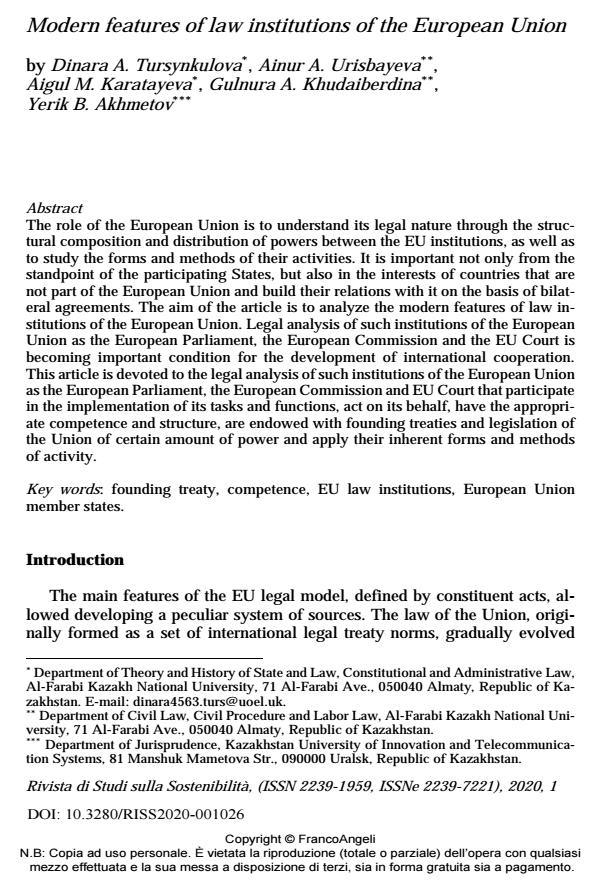Modern features of law institutions of the European Union
Titolo Rivista RIVISTA DI STUDI SULLA SOSTENIBILITA'
Autori/Curatori Dinara A. Tursynkulova, Ainur A. Urisbayeva, Aigul M. Karatayeva, Gulnura A. Khudaiberdina, Yerik B. Akhmetov
Anno di pubblicazione 2020 Fascicolo 2020/1 Lingua Inglese
Numero pagine 18 P. 441-458 Dimensione file 140 KB
DOI 10.3280/RISS2020-001026
Il DOI è il codice a barre della proprietà intellettuale: per saperne di più
clicca qui
Qui sotto puoi vedere in anteprima la prima pagina di questo articolo.
Se questo articolo ti interessa, lo puoi acquistare (e scaricare in formato pdf) seguendo le facili indicazioni per acquistare il download credit. Acquista Download Credits per scaricare questo Articolo in formato PDF

FrancoAngeli è membro della Publishers International Linking Association, Inc (PILA)associazione indipendente e non profit per facilitare (attraverso i servizi tecnologici implementati da CrossRef.org) l’accesso degli studiosi ai contenuti digitali nelle pubblicazioni professionali e scientifiche
The role of the European Union is to understand its legal nature through the struc-tural composition and distribution of powers between the EU institutions, as well as to study the forms and methods of their activities. It is important not only from the standpoint of the participating States, but also in the interests of countries that are not part of the European Union and build their relations with it on the basis of bilateral agreements. The aim of the article is to analyze the modern features of law institutions of the European Union. Legal analysis of such institutions of the European Union as the European Parliament, the European Commission and the EU Court is becoming important condition for the development of international cooperation. This article is devoted to the legal analysis of such institutions of the European Union as the European Parliament, the European Commission and EU Court that participate in the implementation of its tasks and functions, act on its behalf, have the appropriate competence and structure, are endowed with found-ing treaties and legislation of the Union of certain amount of power and apply their inherent forms and methods of activity.
Keywords:Founding treaty, competence, EU law institutions, European Union member states.
- Chetverikov A.O. (2019). The main bodies of the European Union (constitutional and legal aspect). -- Available from: https://eulaw.edu.ru/informatsiya/avtoreferaty-po-pravu-evropejskogo-soyuza/chetverikov-a-o-osnovnye-organy-evropejskogo-soyuz/.
- Craig P.P., De Burca G. (2015). ЕU Law: text, cases, and materials. Oxford University Press, Oxford.
- Entin L.M. (2018). European law. Law sectors of the European Union and the Eurasian Economic Union. Norma, Moscow.
- France v European Parliament. Case С-345/95. ECR1-5215. -- Available from: https://academic.oup.com/yel/article-abstract/23/1/451/1669351?redirectedFrom=PDF.
- Gammeltoft-Hansen T. (2009). Rules of Procedure for the General Council. Adopted on September 1, 1998. Oxford University Press, London.
- Germany v. Commission. Cases 281, 283-5, 287/85. ECR 3203 (para, 28 of the judgment). -- Available from: https://publications.europa.eu/en/publication-detail/-/publication/f50233cb-2d0e-4f85-836b-67ee4fc61f89/language-en.
- Gorbunova N.Ye. (2015). The European Union as a political integration model: theory and practice. Nauka, Moscow.
- Hartley T.K. (2010). Fundamentals of European Community law. Unity, Moscow.
- Hayes-Renshaw F., Wallace H. (2011). The Council of Ministers. Macmillan, London.
- Ibrashev Zh., Yensebaeva E. (2005). Foreign policy of the European Union. Domino PD, Almaty.
- Internal regulations of the European Parliament. -- Available from: http://www.europarl.europa.eu/sides/getDoc.do?pubRef=//EP//TEXT+TA+P5-TA-1999-0086+0+DOC+XML+V0//EN.
- Karmaza O.O., Panfilova Y.M., Saparova A.A., Sheludchenkova A.S., Oriekhov S.M. (2019). Civil law contract: Doctrinal and legal approaches. Asia Life Sciences, 21(2): 821-836.
- Karmaza O.O., Sarana S.V., Fedorenko T.V., Gurzhii T.O., Nefedova A.V. (2018). The protection of civil rights and interests in the court. Journal of Advanced Research in Law and Economics, 9(8): 2622-2630.
- Kashkin S.Yu. (2005). The Law of the European Union. Yurist, Moscow.
- Kudryavtsev V.N. (2019). Crime and mores of a transitional society. Norma, Moscow.
- Ludlow N.P. (2016). Roy Jenkins and the European Commission Presidency, 1976-1980. At the Heart of Europe. Palgrave Macmillan, London.
- Maklakov V.V. (2009). Electoral law of the member states of the European Communities. Russian Academy of Sciences INION, Moscow.
- Mashimbayeva G.A. (2014b). The legal status of supranational construction agencies: the European Commission and the Eurasian Economic Commission. In: Collection of Materials of the International Scientific-Practical Conference “China’s Relations with the Countries of Central Asia: History and Prospects”. Almaty.
- Mashimbayeva G.A. (2014a). The European Commission and the Eurasian Economic Commission: comparative legal analysis. Bulletin of KazNU, 2: 94-101.
- Monnet J. (2018). Memoirs. Garden City. Doubleday, New York.
- Neshatayeva T.N. (2013). Decisions of the European Court of Human Rights: novelties and impact on legislation and law enforcement practice. Norma, Moscow.
- Paveliyeva E.A. (2007). Interaction of the bodies of the European Union and the bodies of the member states. Saint Petersburg State University, Saint Petersburg.
- Stubb А. (2005). Negotiating flexible integration in the Amsterdam treaty in Neunreither and Wiener. London School of Economics and Political Science, London.
- Sylkina S.M. (2017a). Some features of the formation of the European Union legal system. Bulletin of KazNPU, “International Life and Politics”, 3/4(50/51): 49-54.
- Sylkina S.M. (2017b). The modern role of the EU Court in the institutional system of the European Union. Bulletin of KazNPU, “International Life and Politics”, 3/4(50/51): 76-81.
- Tihonovetsky D.S. (2007). Functions and powers of the EU Court of Justice, its role in the institutional structure of the European Communities. Moscow Journal of International Law, 2: 220-225.
- Topornin B.N. (2005). European Communities: law and institutions. Academy of Labour and Social Affairs, Moscow.
- Treaty establishing a Constitution for Europe. -- Available from: https://europa.eu/europeanunion/sites/europaeu/files/docs/body/treaty_establishing_a_constitutio_for_europe_en.pdf.
- Treaty of Amsterdam. -- Available from: http://www.europarl.europa.eu/topics/treaty/pdf/amst-en.pdf.
- Treaty on the European Union (as amended by the Lisbon Treaty). IPP Garant. -- Available from: http://base.garant.ru/2566557/.
- Zelenov R.Yu. (2005). Legal basis of the decision-making process in the system of institutions of the European Union. Nauka, Moscow.
Dinara A. Tursynkulova, Ainur A. Urisbayeva, Aigul M. Karatayeva, Gulnura A. Khudaiberdina, Yerik B. Akhmetov, Modern features of law institutions of the European Union in "RIVISTA DI STUDI SULLA SOSTENIBILITA'" 1/2020, pp 441-458, DOI: 10.3280/RISS2020-001026